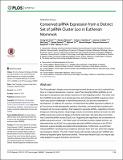Conserved piRNA Expression from a Distinct Set of piRNA Cluster Loci in Eutherian Mammals
Author(s)
Chirn, Gung-wei; Rahman, Reazur; Sytnikova, Yuliya A.; Matts, Jessica A.; Zeng, Mei; Gerlach, Daniel; Yu, Michael; Berger, Bonnie; Naramura, Mayumi; Kile, Benjamin T.; Lau, Nelson C.; ... Show more Show less
DownloadChirn-2015-Conserved piRNA Expr.pdf (3.819Mb)
OPEN_ACCESS_POLICY
Open Access Policy
Creative Commons Attribution-Noncommercial-Share Alike
Terms of use
Metadata
Show full item recordAbstract
The Piwi pathway is deeply conserved amongst animals because one of its essential functions is to repress transposons. However, many Piwi-interacting RNAs (piRNAs) do not base-pair to transposons and remain mysterious in their targeting function. The sheer number of piRNA cluster (piC) loci in animal genomes and infrequent piRNA sequence conservation also present challenges in determining which piC loci are most important for development. To address this question, we determined the piRNA expression patterns of piC loci across a wide phylogenetic spectrum of animals, and reveal that most genic and intergenic piC loci evolve rapidly in their capacity to generate piRNAs, regardless of known transposon silencing function. Surprisingly, we also uncovered a distinct set of piC loci with piRNA expression conserved deeply in Eutherian mammals. We name these loci Eutherian-Conserved piRNA cluster (ECpiC) loci. Supporting the hypothesis that conservation of piRNA expression across ~100 million years of Eutherian evolution implies function, we determined that one ECpiC locus generates abundant piRNAs antisense to the STOX1 transcript, a gene clinically associated with preeclampsia. Furthermore, we confirmed reduced piRNAs in existing mouse mutations at ECpiC-Asb1 and -Cbl, which also display spermatogenic defects. The Asb1 mutant testes with strongly reduced Asb1 piRNAs also exhibit up-regulated gene expression profiles. These data indicate ECpiC loci may be specially adapted to support Eutherian reproduction.
Date issued
2015-11Department
Massachusetts Institute of Technology. Computer Science and Artificial Intelligence Laboratory; Massachusetts Institute of Technology. Department of MathematicsJournal
PLOS Genetics
Publisher
Public Library of Science
Citation
Chirn, Gung-wei, Reazur Rahman, Yuliya A. Sytnikova, Jessica A. Matts, Mei Zeng, Daniel Gerlach, Michael Yu, et al. “Conserved piRNA Expression from a Distinct Set of piRNA Cluster Loci in Eutherian Mammals.” Edited by Cedric Feschotte. PLOS Genetics 11, no. 11 (November 20, 2015): e1005652.
Version: Final published version
ISSN
1553-7404